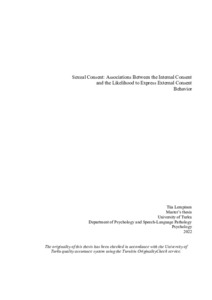Sexual Consent: Associations Between the Internal Consent and the Likelihood to Express External Consent Behavior
Lempinen, Tiia (2022-06-21)
Sexual Consent: Associations Between the Internal Consent and the Likelihood to Express External Consent Behavior
Lempinen, Tiia
(21.06.2022)
Julkaisu on tekijänoikeussäännösten alainen. Teosta voi lukea ja tulostaa henkilökohtaista käyttöä varten. Käyttö kaupallisiin tarkoituksiin on kielletty.
avoin
Julkaisun pysyvä osoite on:
https://urn.fi/URN:NBN:fi-fe2022062749781
https://urn.fi/URN:NBN:fi-fe2022062749781
Tiivistelmä
Sexual consent is a very current and understudied phenomenon. The definitions of sexual consent vary from “the freely given verbal or non-verbal communication of a feeling of willingness”, to an internal state of willingness, as behavior someone else interprets as willingness and as an act of explicitly agreeing to something within a sexual context. An ongoing law reform in Finland aims to improve individuals’ sexual self-determination by defining rape as an act of involuntary sexual intercourse. This implies that the presence of sexual consent will be noted in the legal definition of rape in the criminal code of Finland. According to the proposal, agreeing to sexual intercourse is not considered voluntary if an individual has not expressed ones consent verbally, behaviorally or in some other way. To the best of my knowledge, no empirical studies on the psychological and behavioral correlates of sexual consent have been carried out in Finland despite the present legislative situation. Therefore, sexual consent was now investigated in the Finnish context and defined with consideration to both external and internal aspects of consent in this study. Empirical data on individuals’ internal (willingness to engage in sexual behavior) and external consent (communication of consent) related to their most recent sexual encounter was gathered with an online questionnaire. The questionnaire was distributed on an internet forum (vauva.fi) and via email lists reaching Finnish and Swedish speaking university students around Finland. The collected sample included 381 participants, and confirmatory factor analyses (CFA) and structural regression (SR) models were used to study the associations between internal consent and the likelihood to express external consent behavior. In this study, internal consent feelings predicted nonverbal behavior and borderline pressure. Nonverbal behavior appeared as the most common way to communicate sexual consent, whereas feelings of safety and want were the most strongly agreed feelings. Individuals experiencing more internal consent, were more likely to report nonverbal behavior and borderline pressure. According to this study, it is not recommendable that verbally communicated consent would be the only criteria for sexual consent. Taking psychological and behavioral research into account when working on reforms and legislation is important.
